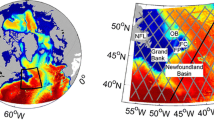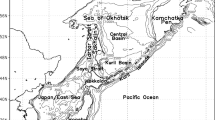Abstract
In order to confirm the results of the authors’ previous work, which found that the existence of disturbances smaller than meso-scale eddies is important in large-scale mixing process between the Oyashio and Kuroshio waters in the intermediate layer, the results of an eddy-resolving model experiment are analyzed and compared with those of an eddy-permitting model. The intermediate salinity minimum given in the initial condition weakens as integration advances in the eddy-permitting model, while it recovers rapidly and is maintained thereafter in the eddy-resolving model, initialized from the unrealistic salinity distribution of the former. Filament-like fine structures in temperature and salinity develop actively in the latter, which are much smaller in horizontal width than meso-scale eddies, suggesting the importance of such disturbances in the large-scale mixing. The mixing ratio of the Oyashio water defined by the original Oyashio and Kuroshio waters shows that its value is generally higher in the intermediate lower sub-layer than in the intermediate upper sub-layer in the Mixed Water Region, and the salinity minimum exists between layers with low and high values of the mixing ratio with its strong vertical gradient. The eddy transports of the Oyashio and Kuroshio waters in an isopycnal layer are divided into four components, usual isopycnal mixing of temperature and salinity being dominant, followed by the component associated with the thickness flux. The southward eddy transport of the Oyashio water and the northward eddy transport of the Kuroshio water are not symmetric to each other because the thickness-flux-associated components are in the same direction (southward).
Similar content being viewed by others
References
Antonov, J. L., S. Levitus, T. P. Boyer, M. E. Conkright, T. D. O’Brien and C. Stephens (1998): World Ocean Atlas 1998 Vol. 1: Temperature of the Atlantic Ocean. NOAA Atlas NESDIS 27, U.S. Government Printing Office, Washington, D.C.
Gent, P. R. and J. McWilliams (1990): Isopycnal mixing in ocean general circulation models. J. Phys. Oceanogr., 20, 150–155.
Gent, P. R., T. Willebrand, T. McDougall and J. McWilliams (1995): Parameterizing eddy-induced tracer transports in ocean circulation models. J. Phys. Oceanogr., 25, 463–474.
Griffies, S. M. and R. Hallberg (2000): Biharmonic friction with a Smagorinsky-like viscosity for use in large-scale eddy-permitting ocean models. Mon. Wea. Rev., 128, 2935–2946.
Hasunuma, K. (1978): Formation of the intermediate salinity minimum in the northwestern Pacific Ocean. Bull. Ocean. Res. Inst., Univ. of Tokyo, 9, 1–47.
Hiroe, Y., I, Yasuda, K. Komatsu, K. Kawasaki, T. M. Joyce and F. Bahr (2002): Transport of the North Pacific Intermediate Water in the Kuroshio-Oyashio Interfrontal zone. Deep-Sea Res. II, 49, 5353–5364.
Hunke, E. C. and J. K. Dukowicz (1997): An elastic-viscous-plastic model for sea ice dynamics. J. Phys. Oceanogr., 27, 1849–1867.
Hunke, E. C. and J. K. Dukowicz (2002): The elastic-viscousplastic dynamic model in general orthogonal curvilinear coordinates on a sphere—incorporation of metric terms. Mon. Wea. Rev., 130, 1848–1865.
Ishikawa, I., H. Tsujino, M. Hirabara, H. Nakano, T. Yasuda and H. Ishizaki (2005): Meteorological Research Institute Community Ocean Model (MRI.COM) manual. Tech. Rep. Meteorol. Res. Inst., 47, 1–189.
Ishizaki, H. (1994): A simulation of the abyssal circulation in the North Pacific Ocean. Part II: Theoretical rationale. J. Phys. Oceanogr., 24, 1941–1954.
Ishizaki, H. and I. Ishikawa (2004): Simulation of formation and spreading of salinity minimum associated with NPIW using a high-resolution model. J. Oceanogr., 60, 463–485.
Ishizaki, H. and T. Motoi (1999): Reevaluation of Takano-Oonishi scheme for momentum advection on bottom relief in ocean models. J. Atmos. Oceanic Technol., 16, 1994–2010.
Kanamitsu, M., W. Ebisuzaki, J. Woollen, S.-K. Yang, J. J. Hnilo, M. Fiorino and G. L. Potter (2002): NCEP-DOE AMIP II reanalysis (R-2). Bull. Amer. Meteorol. Soc., 83, 1631–1643.
Kara, A. B., P. A. Rochfort and H. E. Hurlburt (2000): Efficient and accurate bulk parameterization of air-sea fluxes for use in general circulation models. J. Atmos. Oceanic Technol., 17, 1421–1438.
Kawai, H. (1972): Hydrography of the Kuroshio and the Oyashio. p. 129–320. In Physical Oceanography II, Fundamental Lectures of Oceanography, ed. by M. Iwashita et al., Tokai University Press, Japan (in Japanese).
Kobayashi, T. (1999): Study of the formation of North Pacific Intermediate Water by a general circulation model and the particle-tracking method 1. A pitfall of general circulation model studies. J. Geophys. Res., 104, 5423–5439.
Kobayashi, T. (2000): Study of the formation of North Pacific Intermediate Water by a general circulation model and the particle-tracking method 2. Formation mechanism of salinity minimum from the view of the “critical gradient” of the Oyashio mixing ratio. J. Geophys. Res., 105, 1055–1069.
Kono, T. (1997): Modification of the Oyashio Water in the Hokkaido and Tohoku areas. Deep-Sea Res. I, 44, 669–688.
Kono, T. (1998): Formation of the salinity minimum in the Mixed Water Region between the Oyashio and Kuroshio Fronts. Deep-Sea Res. I, 45, 2035–2057.
Kouketsu, S., I. Yasuda and Y. Hiroe (2005): Observation of frontal waves and associated salinity minimum formation along the Kuroshio Extension. J. Geophys. Res., 110, 1–13, doi:10.1029/2004JC002862.
Kouketsu, S., I. Yasuda and Y. Hiroe (2007): Three-dimensional structure of frontal waves and associated salinity minimum formation along the Kuroshio Extension. J. Phys. Oceanogr., 37, 644–656.
Kuragano, T. and M. Kamachi (2000): Global statistical spacetime scales of oceanic variability estimated from the TOPWX/POSEIDON altimeter data. J. Geophys. Res., 105, 955–974.
Lee, M.-M., A. J. George, A. C. Coward and B. A. De Cuevas (2007): Eddy advective and diffusive transport of heat and salt in the Southern Ocean. J. Phys. Oceanogr., 37, 1376–1393.
Leonard, B. P. (1979): A stable and accurate convective modeling procedure based upon quadratic upstream interpolation. J. Compt. Methods Appl. Mech. Eng., 19, 59–98.
Leonard, B. P., M. K. MacVean and A. P. Lock (1994): The flux integral method for multidimensional convection and diffusion. NASA Tech. Memo., 106679, 27.
Masujima, M., I. Yasuda, Y. Hiroe and T. Watanabe (2003): Transport of Oyashio water across the Subarctic Front into the Mixed Water Region and formation of NPIW. J. Oceanogr., 59, 855–869.
Mellor, G. L. and L. Kantha (1989): An ice-ocean coupled model. J. Geophys. Res., 94, 10937–10954.
Nakamura, T., T. Toyoda, T. Awaji and Y. Ishikawa (2004): Tidal mixing in the Kuril Straits and its impact on ventilation in the North Pacific Ocean. J. Oceanogr., 60, 411–423.
Nakano, H., H. Tsujino and R. Furue (2008): The Kuroshio current system as a jet and twin “ relative” recirculation gyres embedded in the Sverdrup circulation. Dyn. Atmos. Oceans, 45, 135–164.
Niiler, P. P., N. A. Maximenko and J. C. McWilliams (2003): Dynamically balanced absolute sea level of the global ocean derived from near-surface velocity observations. Geophys. Res. Lett., 30, doi: 10.1029/2003GL018628.
Okuda, K., K. Segawa and Y. Hiroe (1995): Observational study in the region of the Kuroshio Extension. J-WOCE Report, 187–204, Japan Science Tech. Agency (in Japanese).
Okuda, K., I. Yasuda, Y. Hiroe and Y. Shimizu (2001): Structure of subsurface intrusion of the Oyashio Water into the Kuroshio Extension and formation process of the North Pacific Intermediate Water. J. Oceanogr., 57, 121–140.
Shimizu, Y., I. Yasuda, K. Okuda, K. Hanawa and S. Ito (2003): ADCP-referenced Kuroshio and Oyashio water transports for North Pacific Intermediate Water formation. J. Phys. Oceanogr., 33, 220–233.
St. Laurent, L., H. L. Simmons and S. R. Jayne (2002): Estimating tidally driven mixing in the deep ocean. Geophys. Res. Lett., 29, 475–501.
Talley, L. D. (1993): Distribution and formation of North Pacific Intermediate Water. J. Phys. Oceanogr., 23, 517–537.
Talley, L. D., Y. Nagata, M. Fujimura, T. Iwao, T. Kono, D. Inagake, M. Hitai and K. Okuda (1995): North Pacific Intermediate Water in the Kuroshio/Oyashio mixed water region. J. Phys. Oceanogr., 25, 475–501.
Tatebe, H. and I. Yasuda (2004): Oyashio southward intrusion and cross-gyre transport related to diapycnal upwelling in the Okhotsk Sea. J. Phys. Oceanogr., 34, 2327–2341.
Uchida, H. and S. Imawaki (2003): Eulerian mean velocity field derived by combining drifter and satellite altimeter data. Geophys. Res. Lett., 30(5), 1229, doi:10.1029/2002GL016445.
Yamanaka, G., Y. Kitamura and M. Endoh (1998a): Formation of North Pacific Intermediate Water in Meteorological Research Institute ocean general circulation model 1. Subgridscale mixing and marginal sea fresh water. J. Geophys. Res., 103, 30885–30903.
Yamanaka, G., Y. Kitamura and M. Endoh (1998b): Formation of North Pacific Intermediate Water in Meteorological Research Institute ocean general circulation model. Transient tracer experiment. J. Geophys. Res., 103, 30905–30921.
Yasuda, I. (1997): The origin of the North Pacific Intermediate Water. J. Geophys. Res., 102, 893–909.
Yasuda, I., K. Okuda and Y. Shimizu (1996): Distribution and modification of North Pacific Intermediate Water in the Kuroshio-Oyashio Interfrontal Zone. J. Phys. Oceanogr., 26, 448–465.
Yasuda, I., Y. Hiroe, K. Komatsu, K. Kawasaki, T. M. Joyce, F. Bahr and Y. Kawasaki (2001): Hydrographic structure and transport of the Oyashio south of Hokkaido and the formation of the North Pacific Intermediate Water. J. Geophys. Res., 106, 6931–6942.
Yoshinari, H., I. Yasuda, S. Ito, E. Firing, Y. Matsuo, O. Katoh and Y. Shimizu (2001): Meridional transport of the North Pacific Intermediate Water in the Kuroshio-Oyashio interfrontal zone. Geophys. Res. Lett., 28, 3445–3448.
You, Y. (2003): Implication of cabbeling on the formation and transformation mechanism of North Pacific Intermediate Water. J. Geophys. Res., 108, 3134, doi:10.1029/2001JC001285.
You, Y., N. Suginohara, M. Fukasawa, H. Yoritaka, K. Mizuno, Y. Kashino and D. Hartoyo (2003): Transport of North Pacific Intermediate Water across Japanese WOCE sections. J. Geophys. Res., 108, 3196, doi: 10.1029/2002JC001662.
Author information
Authors and Affiliations
Corresponding author
Rights and permissions
About this article
Cite this article
Ishikawa, I., Ishizaki, H. Importance of eddy representation for modeling the intermediate salinity minimum in the North Pacific: Comparison between eddy-resolving and eddy-permitting models. J Oceanogr 65, 407–426 (2009). https://doi.org/10.1007/s10872-009-0036-6
Received:
Revised:
Accepted:
Published:
Issue Date:
DOI: https://doi.org/10.1007/s10872-009-0036-6




